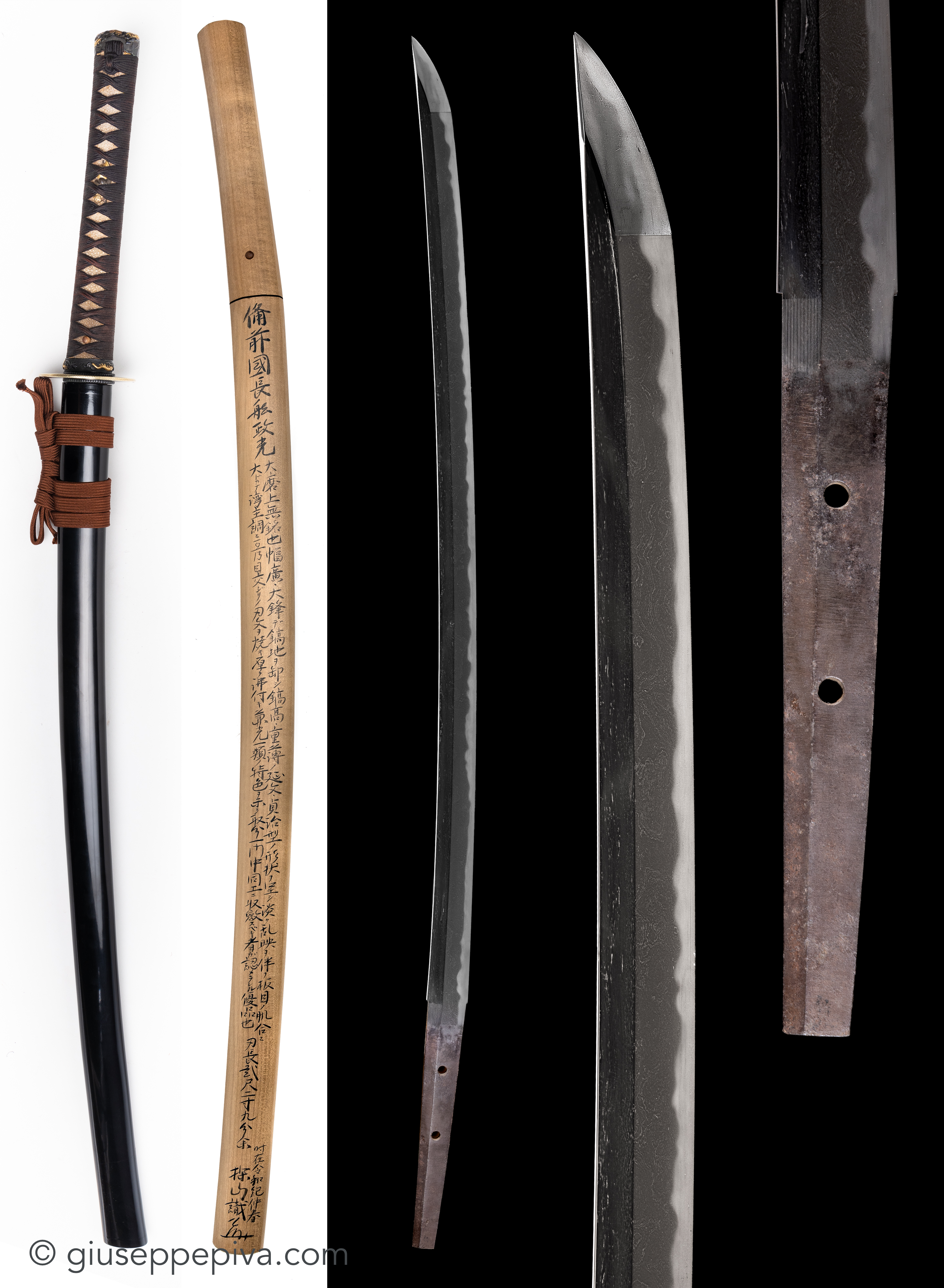An important Soden-Bizen samurai sword by Masamitsu
Mumei
Nanbokuchō Period (1333-1392), circa 1360
NBTHK Jūyō Tōken
-
Nagasa [length]: 69.6 cm
Sori [curvature]: 1.4 cm
Motohaba [bottom width]: 3 cm
Sakihaba [top width]: 2.3 cm
Motokasane [bottom thickness]: 2 mm
-
Sugata [configuration]: Shinogi-zukuri, maru-mune. The blade is wide, with a slight difference between top and bottom, thick kasane, high shinogi, slightly deep sori, ō-kissaki (5.6 cm)
Kitae [forging pattern]: Itame hada mixed with frequent mokume hadatachi. Jinie, fine chikei, pale utsuri
Hamon [tempering pattern]: Ko-notare mixed with ko-gunome, kaku-gunome, ko-choji and togarigokoro. Some ashi, ko-nie, fine sunagashi toward the monouchi, bright nioiguchi
Boshi [point]: Yakifukai, midarekomi, saki-togarigokoro kaeri, hakikake
Nakago [tang]: Ō-suriage, sakikiri, yasurime kiri; two mekugi-ana
-
Origami [certificate]: The blade comes with a Jūyō Tōken (Important Sword) certificate issued by the Nihon Bijutsu Token Hozon Kyokai in 2022 (session nr. 67)
-
Sayagaki [certification on shirasaya]: The inscription by Tanobe sensei reads:
“Bizen [no] Kuni Osafune Masamitsu. Ō-suriage, mumei, wide haba, ō-kissaki, high shinogi with dropping shinogi-ji and thin kasane. The shape style is that of Enbun/Teiji periods [1356–1368]. Itame hada showing a pale midare utsuri. Composed hamon with wide yakihaba and good nie, showing ō-notare mixed with gunome. This sword displays the style of the Kanemitsu school and is a great work with characteristics that, among the school, show that the attribution must be narrowed to this particular swordsmith. Length: slightly more than 2 Shaku 2 sun 9 bu. Midspring during the Reiwa period. Written by Tanzan [Tanobe] Michihiro [+kao]”.
Koshirae [mounts]: The sword is accompanied by a good antique handachi koshirae with a shakudo tsuba rimmed in gold, shakudo-nanako fuchi-kashira and shakudo and gold menuki.
Bizen swords produced during the Nanbokuchō period have special characteristics and are commonly called Soden-Bizen. This style was inaugurated by Osafune Kanemitsu, who contaminated the Bizen tradition with the new Soshu style, resulting in a very interesting and innovative form characterized by expressions of both approaches, with an itame jihada with extended ji-nie and a midareba with profuse nie. Compared to Chogi, the other swordsmith who contributed to the creation of the Soden-Bizen style, Kanemitsu's approach is more subtle and graceful, recalling the elegance of late Kamakura blades. The works of Kanemitsu and his students show some distinctive features belonging to the Soden-Bizen tradition, almost all of which can be observed in this sword, assigned to Masamitsu, student and probably the son of Kanemitsu: the sugata is broad and powerful, the sori is shallow and the kasane thick, with a slight hira-niku. The steel has a tendency to be soft and darkish, worked in itame-hada mixed with mokume. The grain is thick and dense with nie forming chikei, a very difficult workmanship to achieve in soft bizen steel. Sometimes there may be a utsuri, which is very light in the case of this sword, but this is not a common feature. The hamon, generally ō-midare mixed with choji-midare, is broad and refined, usually in nioi deki, as is typical in Bizen tradition, but also with the presence of abundant nie, as is common for Soden-Bizen blades, with numerous ashi, yō, sunagashi, inazuma and kinsuji.
Masamitsu is ranked Jo-jo saku (highly superior) by Fujishiro.
Inventory Nr: 1743
Info works
Copyright © 2016 - giuseppe piva - VAT: 05104180962


